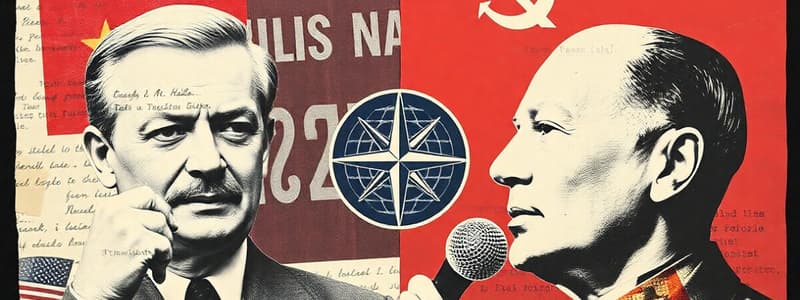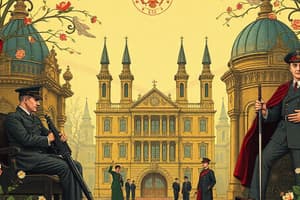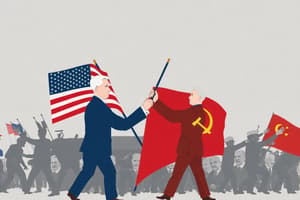Podcast
Questions and Answers
What was a primary concern of the United States that drove its involvement in the Cold War?
What was a primary concern of the United States that drove its involvement in the Cold War?
- Promoting democratic elections within the Soviet Union.
- Preventing the spread of communism and the 'domino effect'. (correct)
- Ensuring fair trade practices with the Soviet Union.
- Establishing military bases in Eastern Europe.
Which concept is characterized by the understanding that a nuclear attack by one nation would inevitably result in a retaliatory strike leading to catastrophic destruction for both parties?
Which concept is characterized by the understanding that a nuclear attack by one nation would inevitably result in a retaliatory strike leading to catastrophic destruction for both parties?
- Non-Aligned Movement
- Mutually Assured Destruction (MAD) (correct)
- Détente
- Proxy War
Which of the following was a key feature of the 'satellite nations' in Eastern Europe during the Cold War?
Which of the following was a key feature of the 'satellite nations' in Eastern Europe during the Cold War?
- Independent military alliances with Western powers.
- Their ability to freely trade with any nation.
- Rejection of Five Year Plans.
- Political and economic dependence on the Soviet Union. (correct)
How did Mao Zedong's policies affect the role of Chinese women?
How did Mao Zedong's policies affect the role of Chinese women?
What was the primary objective of the Cultural Revolution in China?
What was the primary objective of the Cultural Revolution in China?
Which of the following best describes the actions of the Khmer Rouge in Cambodia?
Which of the following best describes the actions of the Khmer Rouge in Cambodia?
What was a significant consequence of Fidel Castro's rise to power in Cuba?
What was a significant consequence of Fidel Castro's rise to power in Cuba?
Which of the following describes the primary goal of the Non-Aligned Movement?
Which of the following describes the primary goal of the Non-Aligned Movement?
What event prompted Egypt to move closer to the USSR during the Cold War?
What event prompted Egypt to move closer to the USSR during the Cold War?
Why did the USSR construct the Berlin Wall?
Why did the USSR construct the Berlin Wall?
In the context of the Cold War, what is a 'proxy war'?
In the context of the Cold War, what is a 'proxy war'?
Which of the following policies is associated with Mikhail Gorbachev and contributed to the fall of the USSR?
Which of the following policies is associated with Mikhail Gorbachev and contributed to the fall of the USSR?
What was the 'military-industrial complex' and why was it a concern?
What was the 'military-industrial complex' and why was it a concern?
How did Deng Xiaoping alter China's economic policies?
How did Deng Xiaoping alter China's economic policies?
What was a primary consequence of the fall of communist Yugoslavia?
What was a primary consequence of the fall of communist Yugoslavia?
What was the primary cause of the rise of al-Qaeda and the Taliban in the Middle East?
What was the primary cause of the rise of al-Qaeda and the Taliban in the Middle East?
What was Gandhi's vision for India's independence?
What was Gandhi's vision for India's independence?
What was a significant challenge faced by Nigeria after gaining independence?
What was a significant challenge faced by Nigeria after gaining independence?
What role did Belgium play in the ethnic tensions in Rwanda?
What role did Belgium play in the ethnic tensions in Rwanda?
For which goal did the Spanish Basques become a terrorist movement?
For which goal did the Spanish Basques become a terrorist movement?
Flashcards
Cold War
Cold War
A period of geopolitical tension between the US and the USSR and their respective allies, beginning after World War II.
MAD (Mutually Assured Destruction)
MAD (Mutually Assured Destruction)
The principle that each side in a nuclear conflict could inflict unacceptable damage on the other, resulting in both sides being destroyed.
NATO
NATO
Defense organization in Western hemisphere (US)
SEATO
SEATO
Signup and view all the flashcards
CENTRO
CENTRO
Signup and view all the flashcards
Warsaw Pact
Warsaw Pact
Signup and view all the flashcards
Satellite Nations
Satellite Nations
Signup and view all the flashcards
The Great Leap Forward
The Great Leap Forward
Signup and view all the flashcards
Cultural Revolution
Cultural Revolution
Signup and view all the flashcards
Khmer Rouge
Khmer Rouge
Signup and view all the flashcards
Shining Path
Shining Path
Signup and view all the flashcards
Non-Aligned Movement
Non-Aligned Movement
Signup and view all the flashcards
Proxy war
Proxy war
Signup and view all the flashcards
Détente
Détente
Signup and view all the flashcards
Gorbachev's Reforms
Gorbachev's Reforms
Signup and view all the flashcards
Perestroika
Perestroika
Signup and view all the flashcards
Glasnost
Glasnost
Signup and view all the flashcards
Balkanization
Balkanization
Signup and view all the flashcards
Decolonization
Decolonization
Signup and view all the flashcards
Holocaust
Holocaust
Signup and view all the flashcards
Study Notes
- The Cold War involved a clash between capitalism, as championed by the US, and communism.
- The US feared a domino effect of communism spreading and used financial and military resources to prevent it.
Parts of the Cold War
- The nuclear arms race led to a state of Mutually Assured Destruction (MAD), creating a balance of terror where any attack would result in global annihilation.
- The Space Race saw the USSR launch the first satellite, Sputnik, in 1957, while the US was the first to put a man on the moon.
Alliances
- The US formed NATO, SEATO, and CENTRO to defend against communism in the Western hemisphere, Southeast Asia, and the Middle East, respectively.
- The USSR created the Warsaw Pact as a defense alliance for the communist Eastern European bloc.
Communist Bloc
- The USSR manipulated smaller Eastern European countries, turning them into satellite nations dependent on the USSR politically and economically.
- These satellite nations had to implement 5-Year Plans and could only trade with each other and the USSR.
- Yugoslavia remained independent from the USSR.
- After WWII, Eastern Europe countries fell under communist rule.
China
- Communists under Mao Zedong won the civil war, promising land reform, recruiting women and peasants, and outlawing arranged marriages.
- Under Mao, China implemented 5-Year Plans, collectivized agriculture with success, and industrialized.
- The Great Leap Forward turned peasant land into communes, leading to famine due to food exports and environmental issues caused by ordering the killing of sparrows.
- The Cultural Revolution aimed to regain popularity and silence critics, with the Red Guard persecuting intellectuals and teachers.
- Nationalists fled to Taiwan.
- Women were considered important as men in the society developed by Mao.
Cambodia
- The Khmer Rouge committed genocide, killing 2 million people, targeting intellectuals and teachers, and forcing people to work on communal farms.
- The Khmer Rouge were overthrown in 1979, but Cambodia remained communist.
Cuba
- A revolution led by Fidel Castro and Che Guevara overthrew the authoritarian leader, with Castro becoming dictator.
- Castro provided food and education to the poor but was repressive, banning free speech, executing opposition, and outlawing Christmas.
Peru
- Peru attempted communism but failed.
- The communist group called the Shining Path used bombings and assassinations to overthrow the government but admitted defeat in 2011.
Non-Aligned Movement
- The Bandung Conference in 1961 condemned colonialism, aiming for cooperation without aligning with the US or USSR, but failed due to conflicting national interests.
- Egypt, under General Abdel Nassar, refused alignment and nationalized the Suez Canal, leading to the Suez Canal Crisis which pulled Egypt closer to the USSR.
- Ghana, under Kwame Nkrumah, attempted to balance between the US and USSR.
Problems in Berlin
- During the Berlin Airlift, the US and GB sent supplies to West Berlin after the USSR blocked access, leading the USSR to back down.
- The USSR built the Berlin Wall to prevent Eastern Berliners from leaving, symbolizing the Cold War.
US Involvement
- In Iran, the US overthrew a socialist leader and supported a pro-American Shah who implemented the White Revolution, which brought social reforms.
- The Shah was overthrown in the 1970s and replaced with a theocracy.
- In Chile, the US supported Agusto Pinochet, who supported capitalism but committed violent acts and was ousted in 1990.
Proxy Wars
- Korea was split into a non-communist South and a communist North, leading to the Korean War and continued division.
- The US's Bay of Pigs invasion in Cuba failed to overthrow Castro. During the Cuban Missile Crisis, the US prevented nuclear weapons from being sent from the USSR to Cuba.
- Vietnam was split after winning independence from France, with the US failing to stop communism from spreading to the South.
- In Angola, the US and USSR backed different tribes amid ethnic tensions after independence.
Détente
- A period of peace between the US and USSR that included a US presidential visit to China and the USSR, the SALT treaty, and better trade relations.
Collapse of USSR
- The Soviets invaded Afghanistan in an attempt to stop a fundamentalist Islamic group from taking control which became a conflict similar to the Vietnam war.
- Uprisings in Poland, Hungary, and Czechoslovakia showed discontent under communism.
- Ronald Reagan ended Détente and aimed to end the USSR.
- Michael Gorbachev introduced Perestroika (private enterprise) and Glasnost (freedom of speech), ended support for satellite nations, and allowed the Berlin Wall to fall.
- The USSR collapsed in 1991.
Legacy of the Cold War
- The military-industrial complex gained excessive power, potentially threatening democracy and causing nuclear war.
Post-USSR Areas
- China, under Deng Xiaoping, underwent economic liberalization, attracting foreign investment, but remained communist with authoritarian control.
- The Tiananmen Square Riots in 1989 led to a violent government crackdown.
- Yugoslavia experienced Balkanization, ethnic cleansing, and land conflicts after the fall of communism.
- In the Middle East, terrorism rose due to religious fundamentalism and weakened colonial powers.
Colonialism
- Colonial powers weakened after WWI/WWII/Great Depression. Colonial leaders demanded independence. The US and USSR supported self-determination to gain new allies in the Cold War.
Decolonization
- Independence was achieved through violence and negotiation.
- Independence was brought about by religious, ethnic, and regional movements.
- Independence led to conflict from the redrawing of boundaries.
- Some colonial subjects move to metropoles.
Decolonization in Asia
- The UN created Israel with Jewish and Arab sectors, leading to wars and Israel gaining more land.
- India was divided into Pakistan (Muslim) and India (Hindu) after debate between the Indian National Council, Gandhi, and the Muslim League, resulting in mass migrations and violence, though India set up democracy.
- There is ongoing tension over Kashmir between Pakistan, India, and China.
- Vietnam fought against France for independence and was split in half by the Geneva Accords into communist North and non-communist South and ultimately became a united communist nation.
Decolonization in Africa
- Ghana, under Kwame Nkrumah, peacefully gained independence in 1957 but was a corrupt dictatorship.
- Nigeria peacefully gained independence in 1960 but faced ethnic tensions and a civil war.
- Tanzania, under Julius Nyerere, gained independence in 1961 and focused on self-reliance and unity but failed to end poverty.
- Uganda, under Idi Amin, had a dictatorship marked by mass executions, terrorism, and economic ruin and was eventually overthrown in 1979.
- In Rwanda, ethnic division between Hutus and Tutsis led to a Hutu-led genocide in 1994, killing around 1 million Tutsis, and Tutsis eventually took control.
- Algeria fought for independence from France and became a one-party socialist state with political instability.
States Advocating for More Autonomy
- In Quebec, the Quiet Revolution sought to split from Canada but was given greater autonomy instead.
- Northern Ireland wanted to join Ireland and became terrorists, but a ceasefire granted more autonomy.
- The Spanish Basques sought independence and became a terrorist movement, but a ceasefire in 2006 granted more autonomy.
Genocides
- Armenian
- Holocaust
- Cambodian
- Bosnian
Studying That Suits You
Use AI to generate personalized quizzes and flashcards to suit your learning preferences.




